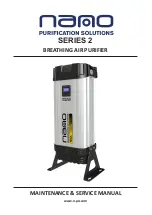
MEES18K085
SAFET
Y
HANDL
ING FOR R3
2
13
5. Regulatory requirements list for safety measures
SAFETY HANDLING FOR R32
5. Regulatory requirements list for safety measures
See below for information on installing a safety device on the HVRF R32 system.
*The requirements listed below were established based on IEC60335-2-40 (ver. 6) and ISO5149 (2014). See the original
standards for further information on selecting a safety device.
<Regulatory requirements for alarm>
<Regulatory requirements for safety shut-off valve>
<Regulatory requirements for mechanical ventilation>
1)
For hospitals, hotels and other buildings, the alarm system shall be required in monitoring room in addition to the living room.
<IEC/GG.10.1/GG.13.2.2><ISO-1/A.5.2.1><ISO-3/8.3.2>
2)
The alarm shall be turned on by the signal from the refrigerant detection system. <IEC/GG.13.1><ISO-1/A.5.2.1>
3)
The alarm shall also alert an authorized person to take appropriate action. <IEC/GG.13.1><ISO-3/8.1>
4)
The alarm system shall warn audibly and visibly such as both a loud buzzer (15 dBA above the background level) and
flashing light. <IEC/GG.13.2.1><ISO-3/8.3.1>
5)
The air conditioner and alarm shall use different electrical power supply. <ISO-3/7.2 and 8.2>
6)
The alarm system shall comply with the requirements of the fire alarms. <ISO-3/8.2>
1)
Safety shut-off valves shall be located outside or in a space with a room volume large enough so that refrigerant
concentration is lower than LFL/4 and LFL/2. <IEC/GG.12.1>
2)
Safety shut-off valves shall be positioned to enable access for maintenance by an authorized person.
<IEC/GG.12.1> <ISO-3/6.4.2>
3)
Safety shut-off valves shall be designed to close in the event of an electric power failure. <IEC/GG.12.2><ISO-3/6.4.3>
4)
Safety shut-off value shall be installed in the place where the amount of refrigerant leaked into the occupied space is less
than QLMV (<LFL/2). <IEC/GG.12.2><ISO-3/6.4.1>
5)
Safety shut-off valve shall shut off the refrigerant under the control of refrigerant leakage detector.
<ISO-1/A.5.2.1, ISO-3/6.4.1>
6)
The air conditioner and safety shut-off valve shall use different electrical power supply. <ISO-3/7.2>
1)
Mechanical ventilation shall be operated continuously or be switched on by the refrigerant detection system.
<IEC/GG.11.3.4><ISO-3/6.3.3.3>
2)
During the continuous operation of the fan, the airflow shall be detected or monitored continuously. If the airflow is reduced,
the unit operation (in heating mode) shall be stopped, or alarm shall be turned on. <IEC/GG.8.3.1>
3)
When the ventilation system is interlocked with the sensor, even if the detcted value of concentration becomes lower than
the one for alert, the ventilation system shall continue to operate more than 5 minutes after the detection and air conditioning
unit shall stop operation. (in heating mode) <IEC/GG.8.3.1>
4)
Air volume of ventilation <ISO-3/6.3.3.1>
Q = 10/RCL (Refrigerant Concentration Limit)
≈
164 m
3
/h
5)
The position of the mechanical ventilation openings <IEC/GG.11.3.3><ISO-3/5.13.1><ISO-3/5.13.5> <ISO-3/6.3.3.2>
The upper edge of the ventilation opening shall be located equal or below the refrigerant release point.
For floor standing units, the lower edge of the opening shall be more than 100 mm above the floor.
The exhaust ventilation openings shall be located a sufficient distance from intake openings to prevent re-circulation to the
occupied space.
6)
(For machinery room) Ventilation route shall be designed to avoid leakage of refrigerant to the neighbouring rooms, corridors
and so on. <ISO-3/5.2>
7)
(For machinery room) Exterior openings shall not be situated within 2 m of building emergency exit staircases or other
building openings, e.g. windows, doors, ventilation inlets, etc. <ISO-3/5.7>
8)
(For machinery room) The ventilation system shall be independent of any other ventilation system. <ISO-3/5.13.1>
9)
The air conditioner and mechanical ventilation shall use different electrical power supply. <ISO-3/7.2 and 8.2>
0000005090.BOOK 13 ページ 2018年12月27日 木曜日 午前10時3分
































